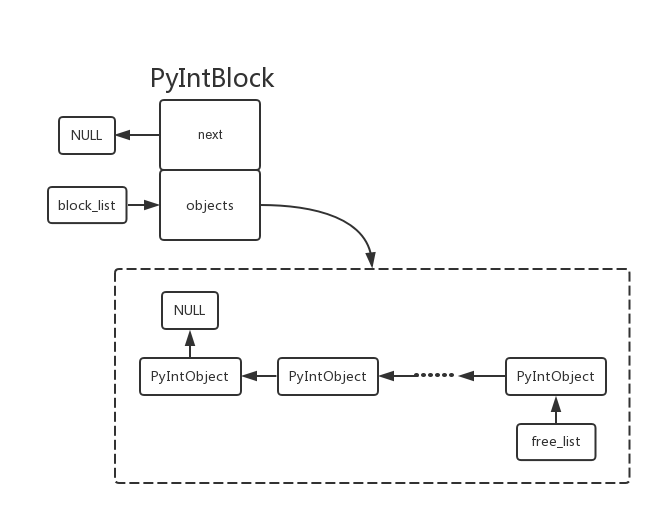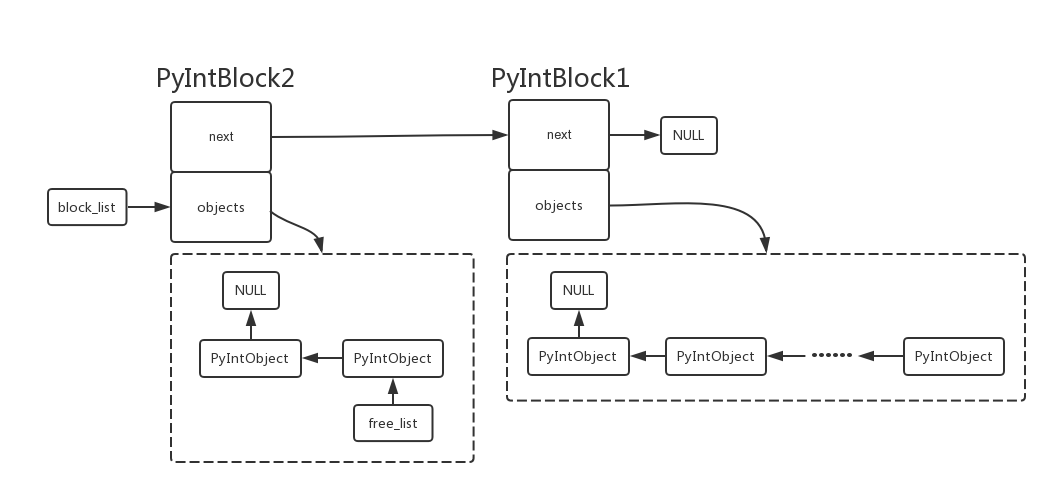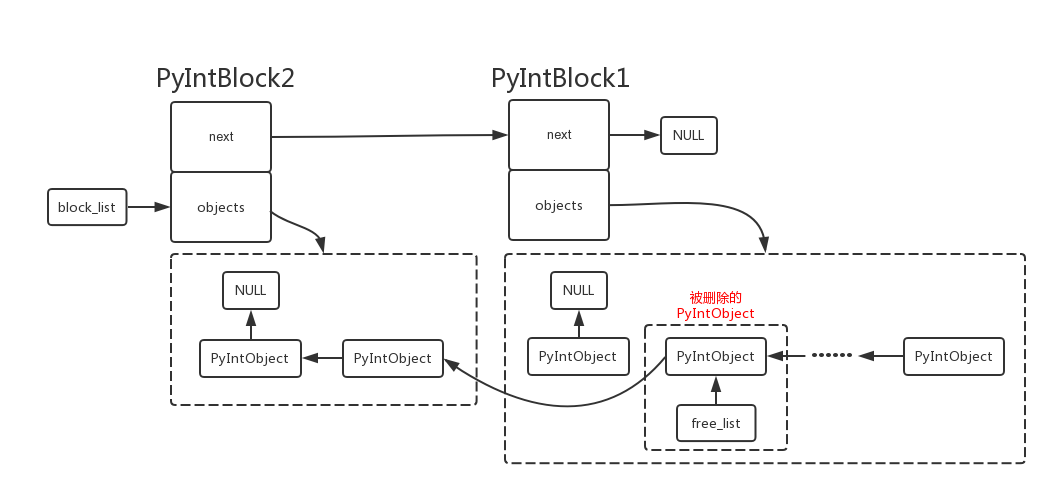1. PyIntObject对象的基本认知
Python的对象可以分为两种:可变对象和不可变对象, PyIntObject属于不可变对象. 也就是说, PyIntObject的值在创建后就无法修改.
Python中的整数使用十分频繁, 如果每个整数对象都要申请内存创建并在结束后释放内存, 那么运行效率将会大大降低. 为解决该问题, Python使用整数对象池.
typedef struct {
PyObject_HEAD;
long ob_ival;
} PyIntObject;
|
PyIntObject实际上是C中原生类型long的包装. Python中的对象的元信息都是保存在对象的类型对象中, PyIntObject的类型对象是PyInt_Type:
PyTypeObject PyInt_Type = {
PyObject_HEAD_INIT(&PyType_Type)
0,
"int",
sizeof(PyIntObject),
0,
(destructor)int_dealloc,
(printfunc)int_print,
0,
0,
(cmpfunc)int_compare,
(reprfunc)int_repr,
&int_as_number,
0,
0,
(hashfunc)int_hash,
0,
(reprfunc)int_repr,
PyObject_GenericGetAttr,
0,
0,
Py_TPFLAGS_DEFAULT |
Py_TPFLAGS_CHECKTYPES |
Py_TPFLAGS_BASETYPE,
int_doc,
0,
0,
0,
0,
0,
0,
int_methods,
0,
0,
0,
0,
0,
0,
0,
0,
0,
int_new,
(freefunc)int_free,
};
|
下面是PyIntObject所支持的操作:
| 函数 |
描述 |
| int_dealloc |
PyIntObject对象的析构操作 |
| int_free |
PyIntObject对象的释放操作 |
| int_repr |
转化为PyStringObject对象 |
| int_hash |
获得HASH值 |
| int_print |
打印PyIntObject对象 |
| int_compare |
比较操作 |
| int_as_number |
数值操作集合 |
| int_methods |
成员函数集合 |
下面可以看到两个整数对象如何对比大小:
static int int_compare(PyIntObject* v, PyIntObject* w)
{
register long i = v->ob_ival;
register long j = w->ob_ival;
return (i < j) ? -1 : (i > j) ? 1 : 0;
}
|
下面是int_as_number:
stati PyNumberMethods int_as_number = (
(binaryfunc)int_add,
(binaryfunc)int_sub,
......
(binaryfunc)int_div,
int_true_divide,
0,
0,
)
|
PyNumberMethods共有39个函数指针, 但并非所有操作都要实现. 作为一个数值操作的例子, 下面是PyIntObject的加法操作:
#define PyInt_AS_LONG(op) (((PyIntObject*)(op))->ob_ival)
#define CONVERT_TO_LONG(obj, lng) \
if (PyInt_Check(obj)) { \
lng = PyInt_AS_LONG(obj); \
} \
else { \
Py_INCREF(Py_NotImplemented); \
return Py_NotImplemented; \
}
static PyObject* int_add(PyIntObject *v, PyIntObject *w)
{
register long a, b, x;
CONVERT_TO_LONG(v, a);
CONVERT_TO_LONG(w, b);
x = a + b;
if ((x^a) >= 0 || (x^b) >= 0)
return PyInt_FromLong(x);
return PyLong_Type.tp_as_number->nb_add((PyObject *)v, (PyObject *)w);
}
|
上述代码中PyInt_AS_LONG是一个macro, 节省了一次函数调用; 但该宏没有类型检查, 牺牲了类型安全. 并且PyIntObject的add操作并没有改变任何一个对象, 而是生成了一个全新的PyIntObject对象. 若加法溢出, 则返回一个PyLongObject对象.
2. PyIntObject对象创建的3种途径
PyObject* PyInt_FromLong(long ival)
PyObject* PyInt_FromString(char* s, char** pend, int base)
#ifdef Py_USING_UNICODE
PyObject* PyInt_FromUnicode(Py_UNICODE* s, int length, int base)
#endif
|
PyInt_FromLong根据long值生成PyIntObject对象, PyInt_FromString和PyInt_FromUnicode根据string和Py_UNICODE生成浮点数, 然后再调用PyInt_FromFloat
PyObject* PyInt_FromString(char *s, char **pend, int base)
{
char *end;
long x;
Py_ssize_t slen;
PyObject *sobj, *srepr;
if ((base != 0 && base < 2) || base > 36) {
PyErr_SetString(PyExc_ValueError,
"int() base must be >= 2 and <= 36");
return NULL;
}
while (*s && isspace(Py_CHARMASK(*s)))
s++;
errno = 0;
if (base == 0 && s[0] == '0') {
x = (long) PyOS_strtoul(s, &end, base);
if (x < 0)
return PyLong_FromString(s, pend, base);
}
else
x = PyOS_strtol(s, &end, base);
if (end == s || !isalnum(Py_CHARMASK(end[-1])))
goto bad;
while (*end && isspace(Py_CHARMASK(*end)))
end++;
if (*end != '\0') {
bad:
slen = strlen(s) < 200 ? strlen(s) : 200;
sobj = PyString_FromStringAndSize(s, slen);
if (sobj == NULL)
return NULL;
srepr = PyObject_Repr(sobj);
Py_DECREF(sobj);
if (srepr == NULL)
return NULL;
PyErr_Format(PyExc_ValueError,
"invalid literal for int() with base %d: %s",
base, PyString_AS_STRING(srepr));
Py_DECREF(srepr);
return NULL;
}
else if (errno != 0)
return PyLong_FromString(s, pend, base);
if (pend)
*pend = end;
return PyInt_FromLong(x);
}
|
3. 小整数对象
实际编程中, 数值较小的整数会频繁使用. 若将所有对象都存储在堆中, 将会频繁申请并释放小整数对象, 导致运行效率降低. Python对小整数对象使用对象池技术, 小整数池的范围如下:
#ifndef NSMALLPOSINTS
#define NSMALLPOSINTS 257
#endif
#ifndef NSMALLNEGINTS
#define NSMALLNEGINTS 5
#endif
|
Python2.5的小整数池范围是[-5, 256], 你也可以修改来实现程序运行速度的提升. 对于其他整数, Python会提供一块内存空间, 由这些大整数轮流使用.
4. 大整数对象
Python由PyIntBlock实现单向列表:
#define BLOCK_SIZE 1000
#define BHEAD_SIZE 8
#define N_INTOBJECTS ((BLOCK_SIZE - BHEAD_SIZE) / sizeof(PyIntObject))
struct _intblock {
struct _intblock *next;
PyIntObject objects[N_INTOBJECTS];
};
typedef struct _intblock PyIntBlock;
static PyIntBlock *block_list = NULL;
static PyIntObject *free_list = NULL;
|
5. 添加和删除
下面是PyInt_FromLong创建PyIntObject的流程:
PyObject* PyInt_FromLong(long ival)
{
register PyIntObject *v;
#if NSMALLNEGINTS + NSMALLPOSINTS > 0
if (-NSMALLNEGINTS <= ival && ival < NSMALLPOSINTS) {
v = small_ints[ival + NSMALLNEGINTS];
Py_INCREF(v);
#ifdef COUNT_ALLOCS
if (ival >= 0)
quick_int_allocs++;
else
quick_neg_int_allocs++;
#endif
return (PyObject *) v;
}
#endif
if (free_list == NULL) {
if ((free_list = fill_free_list()) == NULL)
return NULL;
}
v = free_list;
free_list = (PyIntObject *)v->ob_type;
PyObject_INIT(v, &PyInt_Type);
v->ob_ival = ival;
return (PyObject *) v;
}
|
当首次调用PyInt_FromLong时, free_list为NULL, 从而调用fill_free_list创建新的block
static PyIntObject* fill_free_list(void)
{
PyIntObject *p, *q;
p = (PyIntObject *) PyMem_MALLOC(sizeof(PyIntBlock));
if (p == NULL)
return (PyIntObject *) PyErr_NoMemory();
((PyIntBlock *)p)->next = block_list;
block_list = (PyIntBlock *)p;
p = &((PyIntBlock *)p)->objects[0];
q = p + N_INTOBJECTS;
while (--q > p)
q->ob_type = (struct _typeobject *)(q-1);
q->ob_type = NULL;
return p + N_INTOBJECTS - 1;
}
|
objects被转换成单向链表, 其中next指针使用ob_type, 这样也因此牺牲了类型安全. 以下为程序运行后的结果

当block中的内存都被占满时, fill_free_list会再次申请新的空间, 如下图:

当fill_free_list分配完空间后, Python会从free_list中划出一块并创建PyIntObject对象, 同时完成PyIntObject的初始化工作.
多次fill_free_list后, 每个PyIntBlock的PyIntObject中的objects都是分离的. 假设现在有两个PyIntBlock, PyIntBlock1的objects已经完全填满, PyIntBlock2的objects还未填满, 那么free_list会指向PyIntBlock2中objects的空闲内存块. 当PyIntBlock1中的某个PyIntObject被删除, 下次调用PyInt_FromLong会将新的对象添加到PyIntBlock1的空闲位置. Python销毁PyIntObject时会调整free_list, 以避免内存泄漏.
static void int_dealloc(PyIntObject *v)
{
if (PyInt_CheckExact(v)) {
v->ob_type = (struct _typeobject *)free_list;
free_list = v;
}
else
v->ob_type->tp_free((PyObject *)v);
}
|
int_dealloc完成的只是指针维护. 如果删除的是一个整数的派生类对象, 需调用tp_free彻底销毁对象.

可以发现, int_dealloc没有向系统返还内存, 只是将内存放回内存链表中. 理论上, 整数对象可将系统的内存用光, 但1GB能容乃89478486个整数对象, 所以还是很安全的.
6. 小整数对象池的初始化
small_ints维护的只是PyIntObject的指针, 那么小整数对象在什么时候被创建和初始化? 答案是_PyInt_Init
int _PyInt_Init(void)
{
PyIntObject *v;
int ival;
#if NSMALLNEGINTS + NSMALLPOSINTS > 0
for (ival = -NSMALLNEGINTS; ival < NSMALLPOSINTS; ival++) {
if (!free_list && (free_list = fill_free_list()) == NULL)
return 0;
v = free_list;
free_list = (PyIntObject *)v->ob_type;
PyObject_INIT(v, &PyInt_Type);
v->ob_ival = ival;
small_ints[ival + NSMALLNEGINTS] = v;
}
#endif
return 1;
}
|
Python初始化时调用_PyInt_Init, 申请内存, 并创建小整数对象.


